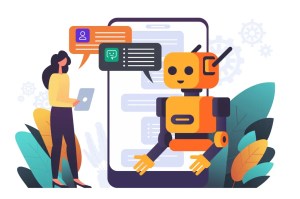Chatbots or artificial intelligence chats are customer service’s new best friends. AI-powered chat assistants are becoming an integral part of our daily lives. Whether we’re seeking customer support or streamlining work processes, these digital helpers are transforming how we communicate.
That’s precisely why we’re here: to talk about artificial intelligence chats and how they can make everyday corporate life more accessible, especially in service, customer service and call centres. Below, you can check out the main topics covered in this article:
- What are AI chats?
- Why use AI chats in customer service?
- How to use artificial intelligence chatbots in your business?
- Top Questions About AI Chatbots
- Did you enjoy learning more about Artificial Intelligence Chat?
4 steps to automate your customer service



What are AI chats?
An artificial intelligence chat is a system that uses AI to simulate human conversations in digital communication channels, such as apps, chats, and websites. This technology allows for a more fluid exchange that is adapted to the user’s needs, in addition to being much faster and relieving call systems.
These AI solutions offer automated, agile, and scalable customer service. Automating conversations reduces the need for human involvement in routine tasks. Imagine having a tireless assistant working 24/7, programmed to interact with customers through their preferred channel, such as WhatsApp.
Artificial intelligence (AI) has been added to chatbot systems that operate according to what was recorded in the database, following predefined words and responses (known as flow chatbots ). Since the operational mode is based on human intelligence or NLP (Natural Language Processing), AI can improve this experience.
Cognitive chatbots use algorithms to understand users through interactions better and offer increasingly “trained” responses, according to the persona and subject recognition.
READ MORE: What Is an AI Chatbot? — And How To Identify Their Must-Have Features
Why use AI chats in customer service?
Artificial intelligence chats can be very useful. After all, this type of solution improves customer service sales and marketing. These systems include confirming appointments, answering common questions about the product/service offered, capturing and qualifying leads, conducting surveys, and triggering automatic communications, among many others.
To make your contact with the customer more agile and less dependent on human action, it is worth considering the application of an AI chatbot in the day-to-day running of the business. In addition, this investment has the following advantages:
- Optimise repetitive processes and tasks.
- Escalate service.
- Reduce operating costs.
- Improve customer experience and satisfaction.
- There is also the advantage of being able to count on greater complexity in interactions, allowing them to be more humanised.
READ MORE: 7 Principles For a Better Customer Experience — Every Time
How to use artificial intelligence chatbots in your business?
The first step in building your chatbot is to consider adopting conversational language that reflects the brand’s tone of voice. Mapping out customers’ main questions and understanding the terms they use most is essential. This can guide the creation of predefined questions to help the conversation.
Creating a “controlled vocabulary guide” helps the chatbot communicate more effectively and in line with user expectations. For example, if the brand’s communication is informal, a chatbot with very formal language and elaborate terms will seem strange. These precautions ensure that your brand has an omnichannel approach.
Important: it is essential to inform users that they are interacting with artificial intelligence and always offer the option of contacting human support if they prefer or need it.
To get the most out of AI technologies, it’s essential to communicate what you want. Prompts are excellent tools for directing and optimising interactions.
The issue of generative AI in chatbots
Generative AI applied to chatbot capabilities can automate the creation of smarter, more personalised chatbot responses that can deeply understand, anticipate, and respond to customer questions. This will build better responses that consider the different nuances of customer questions, helping to increase immediate resolution rates.
With generative AI accessing customer resolution data to analyse sentiment and interaction patterns across conversations, customer service teams can drive continuous improvement, identify trends, and accelerate bot training and updates.
A robust and well-structured database is essential to achieving generative AI’s full potential. The term “garbage in, garbage out” perfectly sums up the importance of the quality of input data for the effectiveness of chatbot responses. If the data submitted to AI algorithms is not accurate, relevant, or comprehensive enough, the responses generated by chatbots will be limited in their usefulness and effectiveness.
Data Cloud, for example, serves as a hyperscale data platform integrated with Salesforce, enabling access, organisation, and analysis of customer data across all of your applications. With various out-of-the-box connectors, teams can establish secure, scalable integrations with various systems, ensuring data consistency across the organisation.
One of the most powerful features of Data Cloud is the ability to create custom data spaces. This allows teams to organise and secure their data by brand, department, and region. This makes it easier to quickly access relevant data and ensures compliance with data privacy and security regulations.
READ MORE: What is an IA Copilot?
Top Questions About AI Chatbots
AI Chatbots vs Chatbots vs Virtual Agents: What’s the Difference?
Non-AI chatbots use scripted dialogue boxes and cannot generate responses that have not been pre-programmed.
AI chatbots use AI, ML NLP, NLP, and LLMs (which are types of linguistic programming) to deliver human-like responses to human input. AI chatbots are trained on large volumes of data and use ML to intelligently generate a wide range of unscripted, conversational responses to human text and voice.
Virtual agents are AI bots that can be specifically trained to interact with customers in call centres. These sophisticated programs use natural language processing and machine learning to understand and respond to customer inquiries in real-time.
What are the common uses of AI chatbots?
AI chatbots are commonly used as call centre solutions, real-time assistance to human agents, generative chatbots, voice capabilities, and sentiment analysis.
How does an AI chatbot work?
An AI chatbot uses natural language processing (NLP) and machine learning algorithms to understand and respond to user input. Here’s a basic breakdown:
- Input processing: The chatbot receives and analyses the user’s message.
- Intent recognition: It identifies the user’s intent using NLP techniques.
- Data retrieval: The chatbot accesses its knowledge base to find relevant information.
- Response generation: It formulates an appropriate response based on the intent and available data.
- Learning: The chatbot stores the interaction, which is used to improve future responses.
As the chatbot interacts more, it refines its understanding and responses, leading to more accurate and natural-sounding conversations. This allows it to grasp context and intent beyond just recognising keywords.
READ MORE: 5 Customer Service Trends You Need to Watch
Did you enjoy learning more about Artificial Intelligence Chat?
Our blog and Resource Centre are always updated with news and content about CRM, technology, and customer service.























